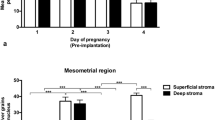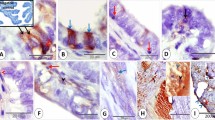Summary
The presence of receptors for steroid hormones in individual cells and tissue sections was assessed within 4–24 h using dry mount autoradiography with radio-iodinated oestradiol. Low affinity and nonspecific binding of steroids were significantly reduced by washing the cells or sections with diluted antiserum to oestradiol.
For cells of the MCF-7 cell line variations in grain density were observed, indicating that cells of the MCF-7 cell line are heterogenous with respect to their cellular receptor concentrations of oestrogen receptors. Receptor-negative cells, such as peritoneal macrophages, did not retain oestradiol label.
In tissue sections of rat and calf uterus, predominant labelling was observed on the endometrial gland cells and stroma.
Oestradiol receptor binding in the uterus cytosol for both radio-iodinated and tritiated oestradiol showed the same qualitative characteristics as determined by sucrose gradient sedimentation profiles and a comparable amount of binding sites was found for both labels. The relative binding affinity of125I-oestradiol compared to [3H]oestradiol is about 70–80%.
The dry mount autoradiographic technique as presented can be used for rapid screening of heterogeneiety in oestrogen receptor distribution in cells and tissue sections, since this technique reveals differences in receptor concentrations on the single cell level.
Similar content being viewed by others
References
Berns, E. m. j. l., Mulder, E., Rommerts, F. f. g., Van der Molen, H. j., Blankenstein, M. a., Boltde vries, J. &De Goeij, T. f. p. m. (1984a) Fluorescent androgen derivatives do not discriminate between androgen receptor-positive and-negative human tumor cell lines.The Prostate 5, 425–37.
Berns, E. m. j. j., Mulder, E., Rommerts, F. f. g., Blankenstein, M. a., De Graaf, E. &Van der Molen, H. j. (1984b) Fluorescent ligands, used in histocytochemistry, do not discriminate between estrogen receptor-positive and receptor-negative human tumor cell lines.Breast Cancer Res. Treatment 4, 195–204.
Buell, R. h. &Tremblay, G. (1981) Autoradiographic demonstration of uptake and retention of3H-estradiol afterin vitro incubation.J. Histochem. Cytochem. 29, 1316–21.
Chamness, G. c. &Mcguire, W. l. (1982) Questions about histochemical methods for steroid receptors.Archs Path. Lab. Med. 106, 53–4.
Chamness, G. c., Mercer, W. d. &Mcguire, W. l. (1980) Are histochemical tests for estrogen receptors valid?J. Histochem. Cytochem. 28, 792–8.
Greene, G. l. &Jensen, E. v. (1982) Monoclonal antibodies as probes for estrogen receptor detection and characterization.J. Steroid Biochem. 16, 353–9.
Grill, H. i., Manz, B., Belovsky, O., Krauzelitzki, B. &Polow, K. (1983) Comparison of [3H]-estradiol and [125I]-estradiol as ligands for estrogen receptor determination.J. clin. Chem. clin. Biochem. 21, 175–9.
Hochberg, R. b. (1979) Iodine-125-labelled estradiol: a gamma-emitting analog of estradiol that binds to the estrogen receptor.Science 205, 1138–40.
Hochberg, R. b. &Rosner, W. (1980) Interaction of 16-[125I]iodo-estradiol with estrogen receptor and other steroid binding proteins.Proc. natn. Acad. USA 77, 328–32.
King, W. j. &Greene, G. l. (1984) Monoclonal antibodies localize estrogen receptors in the nuclei of target cells.Nature, Lond. 307, 745–7.
Lee, S. h. (1981) The histochemistry of estrogen receptors.Histochemistry 71, 491–500.
Martin, P. m., Magdelenat, H. p., Benyahia, B., Rigaud, O. &Katzenellenbogen, J. a. (1983) New approach for visualizing estrogen receptors in target cells using inherently fluorescent ligands and image intensification.Cancer Res. 43, 4956–65.
Mccarty, U. s., Jr., Woorlard, B. h., Nicols, D. e., Wilkinson, W. &Mccarty, K. s. Sr. (1980) Comparison of biochemical and histochemical techniques for estrogen receptor analyses in mammary carcinoma.Cancer 46, 2842–5.
Mcguire, W. l. (1980) Steroid hormone receptors in breast cancer treatment strategy.Recent Prog. Horm. Res. 36, 135–56.
Henci, I., Dandliker, W. b., Meyers, C y., Marchetti, E., Marzola, A. &Fabris, G. (1980) Estrogen receptor cytochemistry by fluorescent estrogen.J. Histochem. Cytochem. 28, 1081–8.
Henci, I., Piffanelli, A., Beccati, M. d. &Lanza, G. (1976)In vivo andin vitro immunofluorescent approach to the physiopathology of estradiol kinetics in target cells.J. Steroid Biochem. 7, 883–90.
Perischuk, L. p., Tobin, E. h., Tanapat, P., Gaetjens, E., Carter, A. c., Bloom, N. d., Macchia, R. i. &Eisenberg, K. b. (1980) Histochemical analyses of steroid hormone receptors in breast and prostate carcinoma.Histochem. Cytochem. 28, 799–810.
Fieslor, P. c., Gibson, R. e., Eckelman, W. c., Oates, K. k., Cook, B. &Reba, R. c. (1982) Three radioligands for determining cytoplasmic estrogen receptor content of human breast carcinomas.Clin. Chem. 28, 532–7.
Press, M. f. &Greene, G. l. (1984) Method in laboratory in vestigations. An immunocytochemical method for demonstrating estrogen receptor in human uterus using monoclonal antibodies to human estrophilin.Lab. Invest. 50, 480–6.
Stumpf, W. e. (1968) Subcellular distribution of3H-estradiol in rat uterus by quantitative autoradiography—A comparison between3H-estradiol and3H-norethynodrel.Endocrinology 83, 777–82.
stumpf, w. e. &sar, m. (1975) Autoradiographic techniques for localizing steroid hormones. InMethods in Enzymology, Vol. 36A (edited byo'malley, b. w. andhardman, j. g.), pp. 135–56.
stumpf, w. e. &sar, m. (1976) Autoradiographic localization of estrogen, androgen, progestin and glucocorticosteroid in ‘target tissues’ and ‘non-target tissues’. InReceptors and Mechanism of Action of Steroid Hormones, Part I (edited bypasqualini, j. r.), pp. 41–84.
Tercero, J. c., Nelson, J. c. &Broughton, A. (1981) 16α-[125I]-β-estradiol compared with [3H]-β-estradiol as the tracer in estradiol receptor assays.Clin. Chem. 27, 1913–7.
Author information
Authors and Affiliations
Rights and permissions
About this article
Cite this article
Berns, E.M.J.J., Rommerts, F.F.G. & Mulder, E. Rapid and sensitive detection of oestrogen receptors in cells and tissue sections by autoradiography with125I-oestradiol. Histochem J 17, 1185–1196 (1985). https://doi.org/10.1007/BF01002501
Received:
Revised:
Issue Date:
DOI: https://doi.org/10.1007/BF01002501




